What is Sway Posture?
Sway posture is a term that relates to a certain type of standing posture where people tend to lock their knees in and throw their hips too far forward. This is a very easy way for some people to stand, but it may be that this standing posture might not be the best for you or your pain.
Is There a Perfect Standing Posture?
There is no one ‘perfect posture’ and too often people are made to feel overly self-conscious and worried about the way they stand. In an effort to maintain such a perfect posture, excessive muscle tension can develop, which in turn may contribute to pain and fatigue.
We are, however, all slaves to gravity and where and how we hold our bodies will influence the way gravitational forces are absorbed and shared by our bones, joints and muscles. Human beings evolved some very energy efficient strategies for resisting the forces of gravity in upright standing. If the spine and bones of the pelvis and legs are relatively vertically aligned, passive structures such as bones and ligaments absorb most of the gravitational load. This means that the amount of energy expended by muscles is relatively low.

Why Might My Standing Posture known as “Sway Posture” Affect My Pain
Substantial shifts in the relative alignment of the body parts will ultimately effect efficiency and where load is absorbed.
A common habitual posture is one in which the hip and pelvis is translated forward relative to the line between the ankle and the shoulder (see picture below) often a standing posture know and described as “sway posture”.
The line of gravity now falls behind the hip joint, resulting in a forward that increases load at the front of the hip. The muscles, tendons and ligaments at the front of the hip and/or pelvis will be exposed to greater stretching loads, while the lower back is relatively more compressed. In order to resist gravity now, higher muscle activity around the front of the thighs and hips and at the back of the lower legs, in the calves, is usually needed.
This posture is then not so efficient and enough time spent in such postures may over time contribute to fatigue, overload and ultimately pain at the front of the hip and/or in the lower back.

Ways to Improve Your Standing Posture if you have a “Sway Posture”
Simple tips to improve energy efficiency and reduce hip and back pain in standing posture:
- Think tall (Gently elongate your body, taking the crown of the head towards the sky)
- Draw the pelvis back over the ankles, so the shoulders, hips, and ankles are in a more vertical alignment
- Shift the weight from the balls of the feet, more towards the heels
(This should happen automatically with the first 2 tips) - Achieve a relaxed, tall, balanced posture without consciously gripping any muscles – remember we are aiming for an energy-efficient posture!
How to Change Your Standing Posture to Improve Your Sway Posture: check out this easy to follow short video clip.








